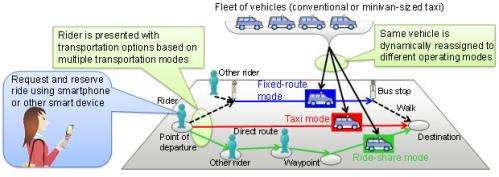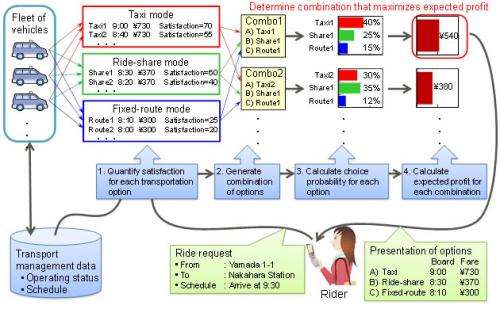Figure 1: On-demand transport service using this technology
Fujitsu Laboratories today announced the development, in collaboration with the Massachusetts Institute of Technology, of an on-demand transport technology that responds to the various needs of transport users while improving profits for transport service operators.
As cities across the world seek to reinvent themselves from the perspective of sustainability, taking into account both the environment and aging populations, there is a clear awareness of the need to create a transport infrastructure for everyday life that does not rely on the excessive use of private cars. While local transportation services involving buses running on regular routes and taxis have been available, an issue has been how to meet diverse user needs while increasing profitability for transport service operators.
Fujitsu Laboratories and MIT have developed an on-demand transport technology that dynamically assigns the same vehicle to a different mode of transportation, such as either a taxi or ride-share car, depending on demand. This allows users to choose their mode of transportation among several options, and also improves the profitability of fleet operators.
In a simulation experiment conducted in a Tokyo suburb, the proposed system was found to increase service operator profits by as much as 80% above conventional methods.
This technology will be exhibited at Fujitsu Forum 2014, running May 15-16 at Tokyo International Forum in Tokyo.
As cities across the world seek to reinvent themselves from the perspective of sustainability, taking into account both the environment and aging populations, there is a clear awareness of the need for local transportation services that are both convenient and affordable. On-demand transport services are currently being used, with local community buses offering extensive coverage of a particular area, as well as on-demand reservation-based ride sharing. However, most of these service operators, mainly local governments, have been put under financial pressure as profitability has been difficult to achieve. Taxis are another means of local transport, but they operate at a price that makes every-day use unrealistic. Consequently, there is a need for local transportation services that can be used on a daily basis by most riders and that enable operators to improve their profits.
Figure 2: How transportation options are optimized and presented to the rider
Fujitsu Laboratories and MIT Professor Moshe E. Ben-Akiva's research group have moved forward with the joint development of an on-demand transport technology that meets diverse needs and improves profitability for service operators by balancing supply and demand through dynamic control of service vehicles.
In existing on-demand transport systems, the allocation of vehicles is static, meaning fluctuations in the transit demands of transport users can lead to a surplus of vehicles in service at a given time, or to an excess of vacant seats. This may mean a reduction in service operator profits. With taxis, for example, a sudden downpour can cause a spike in demand, leading to a shortage of vehicles and an increase in waiting times. This could cause users to resort to other methods of transport such as the family car, in which case taxi businesses lose revenue opportunity.
Fujitsu Laboratories and MIT have developed a new on-demand transport technology that dynamically reassigns the vehicles to different operating modes to avoid vehicle oversupply or shortages. Riders can choose which mode of transportation they wish to use among several options, while transport service operators can maximize profits at the same time (Figure 1).
With this technology, a conventional- or minivan-sized taxi can be dynamically assigned to operate in taxi mode, ride-share mode, or fixed-route mode. Riders notify service operators of ride requests using smartphones or other smart devices, and are presented with options for transportation mode, boarding time, and fares. This makes the system responsive to a variety of transit needs.
The optimization framework optimizes the transportation options based on passenger choice in order to maximize operator profits as follows (Figure 2):
- Quantify degree of satisfaction for each transportation option based on price, wait time, ride time, deviation from desired schedule, and transportation mode.
- Generate combinations of feasible transportation options.
- Calculate which option from the combinations is likely to be chosen, and the probability of that choice, based on a predictive model of selection behavior.
- Based on the choice probability for each transportation option and the profit to be earned from each transportation option, select and present the combination that is expected to maximize operator profits.
This optimization framework, which presents options in response to each ride request, can balance supply and demand and increase operator profits.
For instance, when there are a lot of riders going in the same direction at the same time, that will favor ride-share and fixed-route modes, and when there are few riders going in the same direction at the same time, taxi mode will prove more likely.
This technology improves the robustness of the transportation system to supply/demand imbalances, and is responsive to a variety of mobility needs while maximizing operator profits.
In a simulation experiment conducted in a Tokyo suburb, operator profits were found to be approximately 80% higher than the case when they operated exclusively in taxi mode.
Fujitsu Laboratories will test outcomes under a variety of simulator conditions and verify effectiveness in regional field tests with the goal of practical implementation in fiscal 2016.
Provided by Fujitsu





















